You will be met at the airport by your vehicle hire representative and driven the short distance to the car hire depot, where you will be familiarised with your 4x4.
From here you will set off to your accommodation.
The vehicle comes with standard insurance - other insurance options are available upon request
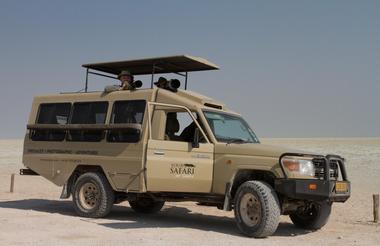
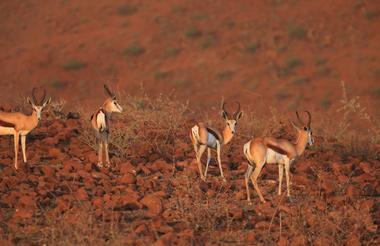
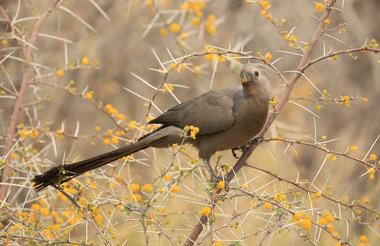
Your vehicle will become your best friend on this self-drive adventure so we only use vehicles that are less than 2 years old. They all come with 2 spare tyres and a compressor ( just in case ) and are fully equipped with roof top tents, a fridge, table and chairs, lights, bedding and all the catering equipment you will need.
You leave Windhoek this morning and travel over the Spreetshoogte Pass and on to the Namib / Sossusvlei Park to Sesriem Campsite. This beautiful camp lies within the national park and the individual pitches are situated under ancient camel thorns overlooking the red dunes.
There is a shop, a restaurant and pool at this site
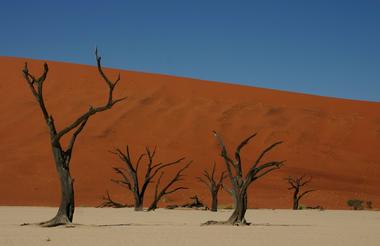
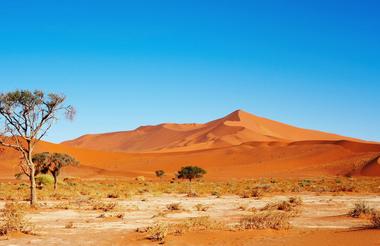
Try to leave early this morning and ensure you buy your groceries before you leave the city. Further on in your tour you will be able to restock in Swakopmund
A very early start is advised for you to drive into the heart of this ancient desert in time to watch the sun rise over the largest sand dunes in the world. If you are still feeling energetic in the afternoon then a walk down Sesriem Canyon is a must with its narrowing sides and rock pools just right for cooling off after your trek.

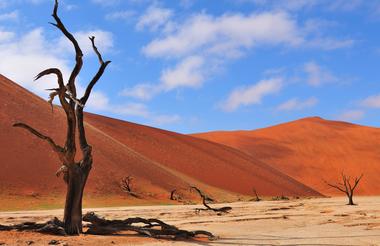
Nearby Elim Dune is an excellent spot for a sundowner. The area is home to many of the desert dwelling antelope and ostriches who make their way back to the dunes at dusk from their day feeding on the grasslands. There is a huge sociable weavers' nest at the foot of the dune and these small noisy birds fly over your head in order to get back to their roost.
A long drive today but an interesting one. Over the Tropic of Capricorn and through canyons until you reach the ocean.
It's worth stopping at Solitaire to enjoy some of Moose's famous apple crumble before heading off west through the Namib.
Located at the Swakopmund River Mouth, mere metres from the beach, Alte Brucke is a neat campsite with lovely private sites and sprawling communal lawn.



En route to the coast you will pass over the Tropic of Capricorn and on through two canyons, the Gaub and the Kuiseb Canyons.
Ensure you have refuelled in Sesriem before you leave although there is a back-up petrol station in Solitaire
You have a full day to explore Swakopmund and participate in one of the many activities on offer in this quirky, adventure capital of the country.
Our particular favourites are going out into the Namib with Desert expert Tommy Collard or out on a seal and dolphin tour in Walvis Bay harbour. But here you can quad bike through the dunes, ride through them or sand board down them - the choice is endless

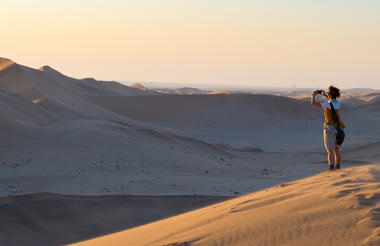

Just along the street from your campsite is the Tiger Reef Bar which sits right on the beach. It is a fun place to watch the sun go down with a cool beer, a glass of wine and some good simple food
You head up the coastal road this morning until you reach Henties Bay where you turn off into the desert on the gravel road. Lunch can be taken in the one-horse town of Uis and then you continue north through the Herero heartland before you reach Mowani and the giant red boulders that define this area.
Mowani Campsite is well situated for visits to the nearby Twyfelfontein Rock Engravings, the organ pipes and petrified forest and there is always a chance of seeing desert elephants in this area


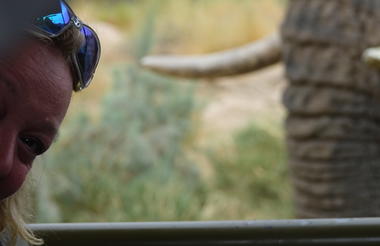
En route you will pass the Brandberg which is Namibia's highest mountain before reaching the area of huge red boulders around Mowani.
You have time this morning to visit the UNESCO World Heritage Site of Twyfelfontein Rock Engravings as well as the nearby Organ Pipes rock formation and and the Burnt Mountain.
The journey from Mowani to Palmwag is arguably one of the most scenic in Namibia, as you travel over mountain passes and through sandy rivers before you reach the wildlife concession.
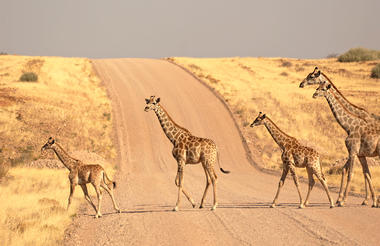
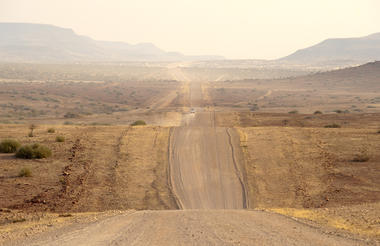
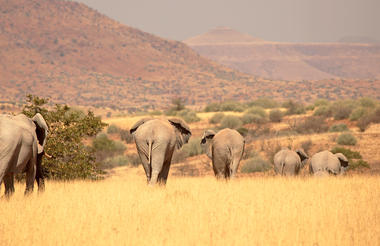
Just before Palmwag you will need to stop at the veterinary checkpoint where the guards will ask you to fill in their register with your travel details that day. This is just a formality as they are trying to prevent the spread of foot and mouth disease.
You will go through the same process when you leave Palmwag but this time you are not allowed to take any meat products through the gate so ensure you have eaten everything the night before!
There are a number of activities on offer at the lodge including rhino tracking in the concession but equally you will be able to buy a map and a permit to self drive into the wildlife area.
The area is unbelievably vast and beautiful but with the added advantage of some of Namibia's most iconic wildlife
The predator population here is the largest outside of the Etosha National Park, with over 100 lions, cheetah, leopard, brown and spotted hyena. Bird life is prolific and diverse with most of Namibia's endemics present. This concession supports a healthy population of desert adapted black rhino and elephants



Palmwag has 2 very inviting swimming pools and the poolside bar has draught beer and serves lovely snacks throughout the day. There is also a fuel station just outside the gate so ensure you refuel before you head off.
A long drive today, but an interesting one, try and leave the lodge as early as possible and drive over the Grootberg Pass to the one-horse town of Kamajab where you can refuel and have a spot of lunch before heading back onto the tar road to the Andersson Gate in Central Etosha to begin your safari in this world famous wildlife sanctuary. This huge park is home to an amazing diversity of wildlife and the area around Okaukuejo is known for its open plains and wide vistas where vast herds of herbivores trek endlessly to the camp’s floodlit waterhole followed by the ever present carnivores looking for their next meal. The floodlit waterhole at Okaukuejo is a real bonus with nightly visits by elephants and black rhino along with many of Etosha’s other wildlife species.



The small town of Kamanjab is a great place to stop for lunch and also to buy the groceries you will need for your time in Etosha.
You have the whole day to explore the open plains that surround Okaukuejo Camp and the Mopane woodlands east of the camp around Olifantsbad waterhole.
Check the sightings book twice a day to check on any major recorded sightings and spend our morning and afternoon drives in search of Etosha's wildlife.
At the camp's own waterhole large herds of elephants often come down to drink and dust bathe before heading back into the bush and black rhinos often frequent the whole from 9pm onwards and throughout the night



The Okondeka waterhole on the pan’s edge is often frequented by one of the largest lion prides in the area and to the east of the camp are three further productive waterholes known for elephants, lion, leopard, spotted and brown hyena, zebra, gemsbok, springbok, wildebeest, ostrich and occasionally aardwolf. The open plains are also good for the larger birds of prey such as vultures, several eagle species and peregrine falcons.
You head east once more today towards Namutoni Camp and the wildlife rich acacia woodland around Fischer’s Pan. Not only is this area home to some of Etosha’s largest lion prides, leopard sightings here are frequent, this area is home to the majority of the park’s giraffe and it is one of the best places in Africa to see the world’s smallest antelope, the diminutive Damara Dik-Dik.



Namutoni Area Highlights: within a few kilometres from camp there are several excellent waterholes and two in particular are productive all day. There is a very large hyena clan near one of the waterholes and the members are often seen returning to their den early in the morning. All the main carnivores are often spotted in this area and cheetah are often seen hunting around Fischer’s Pan. Good area for lion, hyena, leopard, cheetah, elephants, black rhino, damara dik-dik, all plains game, warthogs and mongooses. Flamingos and pelicans can be seen in Fischer’s Pan after the rains.
There are many key waterholes within a few kilometres of Namutoni Camp so you can spend your game drives looping back to camp for quick comfort breaks before you head off again to other areas.
The camp has a lovely pool area that sells lunchtime toasties and beers and the evening restaurant has an outside seating area and good food.



Evening drives are best spent at two productive waterholes,: Chudop is good both early morning and all day for herbivores, especially giraffe. For the last hour Klein Namutoni waterhole is often very rewarding and has perfect photographic light and offers the added bonus of a perfect African sunset on the way back to camp
The road between the camp and Twee Palms waterhole is especially good for cheetah sightings particularly in the mornings and Klein Namutoni waterhole along Dik-Dik Drive is the perfect place for a sundowner as the wildlife come to drink at dusk the light is golden as the sun sets



An early start for you for your last really long driving day back down the tar road until you reach the gates to Okonjima. The lodge lies a further 24km into the middle of the mountains and it is here you will spend your last night searching for some of the Africa’s biggest carnivores. A visit to the Africat Foundation is a must and your campsite is luxury itself with your own ablutions and kitchen and a shared pool. Often you have warthogs grazing on your lawn and many of Okonjima's wildlife species visit the area at night. With its genuine conservation story, Okonjima is always a highlight of any trip to Namibia.



Okonjima's Omboroko Campsite is a luxury campsite and a wonderful place to spend your last night in Namibia - it is also home to the AfriCat Foundation.
Africat is a non-profit organisation set up to support conservation through education and to help secure the future of Namibia's endangered carnivores.
With opportunities to track leopard in the 54,000 acre reserve and the new Endangered Wildlife Trail. Okonjima gives you chances to see some of Africa's rarely seen animals such as brown hyena, aardwolf, aardvark and pangolin
Whilst staying at the lodge you will be able to actively observe part of this programme and understand how Africat aims to protect and rehabilitate these endangered carnivores.
At the Carnivore Care Centre you will have the opportunity to photograph cheetah in their natural habitat within their large enclosures while your guide explains in detail how the programme works.
You head back down the tar road this morning to Windhoek where you can drop off your vehicle before being transferred back to the airport in time for your onward flight






